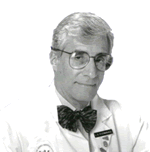 Dear Colleague:
Dear Colleague:
On March 24, 1882, Robert Koch announced his discovery of the tubercle bacilli. To commemorate this event, the New Jersey Medical School will be hosting its first annual Reynard J. McDonald World TB Day Lecture on March 25th in Newark. Dr. Michael Iseman who did his pulmonary training in Harlem with Dr. McDonald, will be the first lecturer. Later that day, Dr. Iseman will present a case of drug-resistant TB at our bimonthly Web-Based TB Grand Rounds for TB program medical consultants in the Northeastern Region. I am glad to see that a number of you are also planning educational and awareness activities associated with World TB Day. This issue features two upcoming RTMCC products, Cultural Competency and TB Care: A Guide for Self Study and Self Assessment, and What Parents Need to Know About Tuberculosis (TB) in Children. We also describe a recent web-based seminar on Surgical Interventions in the Management of TB which will be archived on our website. Finally, this issue features a profile of Dr. George McSherry who oversees pediatric services at the NJMS Global TB Institute. And, as usual, if you have any feedback for any of us, on any TB related topic, I invite you to contact me or a member of our RTMCC staff at 973-972-3270.
Lee B. Reichman, MD, MPH
Executive Director
Northeastern RTMCC and the
Global Tuberculosis Institute
back to top
Training Courses: Bringing Medical Updates to a New Level: A Web-Based Seminar on Surgical Interventions in the Management of Tuberculosis
As tuberculosis rates decline, expertise and experience decline with them. However, cases are more complex than ever, especially those involving drug resistance. Surgical interventions in tuberculosis have had a long history, but have always been either a last, and extremely challenging resort for unresolved cases or used as part of diagnostic procedures.
In response to evaluation results from clinical training courses, input from the RTMCC Advisory Council, and various consensus reports and literature on the management of drug-resistant tuberculosis, we conducted a web-based seminar, titled “Surgical Interventions in the Management of Tuberculosis.” Held on February 13, 2008, this 90- minute program touched briefly upon the history of tuberculosis surgery, but primarily revolved around the use of surgery today in both the diagnosis and management of tuberculosis patients. The presentation was given by Dr. Paul Bolanowski, one of a handful of the country’s cardiothoracic surgeons who have experience with tuberculosis surgery. Dr. Bolanowski described surgical indications for tuberculosis including the persistent failure of medical treatment. However, he also emphasized the importance of the close collaboration between the medical and surgical teams in the care of tuberculosis patients. This was most evident in listening to the case presentation led by Dr. Alfred Lardizabal, a pulmonary and critical care physician and internationally known tuberculosis expert. During the web-based seminar, Dr. Lardizabal presented the cases while “conversing” with Dr. Bolanowski on how the 2 collaborated in managing these cases. It was particularly instructive listening to the rapport between these 2 physicians and an effective learning experience both in clinical and shared case management.
The seminar ended with questions and discussion, moderated by Dr. Lee Reichman. There were specific questions on surgical procedures, as well as discussion about post-surgical care and events leading up to deciding whether a patient is a surgical candidate. There were 34 sites logged into the seminar compromising at least 50 persons total. The program was very well received based on the evaluation results. Over 90% of respondents stated that the learning objectives were clearly addressed, and that the topics were relevant, timely, and communicated with clarity. On a scale of 1-4 (4 being the highest), 90% of respondents rated faculty with the highest rating. Specifically, participants commented that the presentations were clear and easy to follow, and that they would make changes to their own practice and continue to find out more about surgical interventions in the management of tuberculosis.
Drs. Bolanowski and Lardizabal are both medical consultants for the RTMCC and can be reached for consultation by calling 1-800 4TB DOCS. This seminar will be available as an archive at the end of March 2008. It can be accessed by visiting: http://www.umdnj.edu/globaltb/audioarc hives.htm.
Submitted by Rajita Bhavaraju, MPH, CHES, Training and Consultation Specialist Northeastern RTMCC
back to top
Staff Profile: Dr. George D. McSherry
 Dr. George McSherry has been the pediatric pillar of the New Jersey Medical School (NJMS) National Tuberculosis Center since its inception in 1994 and through its evolution into the NJMS Global Tuberculosis Institute (GTBI) in 2005. Widely respected as a clinician, educator, medical consultant, and researcher, Dr. McSherry serves as faculty in TB clinical courses sponsored by GTBI; additionally, he provides pediatric TB consultation to TB program staff and other health care providers throughout the Northeastern Region. Officially, he is Co- Director, Pediatric Services of the GTBI, as well as Associate Professor of Pediatrics at the NJMS. Dr. McSherry is an experienced infectious disease specialist, with nearly 20 years experience treating children with TB and HIV infection. He also serves as Pediatric TB Consultant to the New Jersey Department of Health and Senior Services.
Dr. George McSherry has been the pediatric pillar of the New Jersey Medical School (NJMS) National Tuberculosis Center since its inception in 1994 and through its evolution into the NJMS Global Tuberculosis Institute (GTBI) in 2005. Widely respected as a clinician, educator, medical consultant, and researcher, Dr. McSherry serves as faculty in TB clinical courses sponsored by GTBI; additionally, he provides pediatric TB consultation to TB program staff and other health care providers throughout the Northeastern Region. Officially, he is Co- Director, Pediatric Services of the GTBI, as well as Associate Professor of Pediatrics at the NJMS. Dr. McSherry is an experienced infectious disease specialist, with nearly 20 years experience treating children with TB and HIV infection. He also serves as Pediatric TB Consultant to the New Jersey Department of Health and Senior Services.
Dr. McSherry was exposed to the medical field at an early age. At age 9 he worked in his grandfather’s pharmacy in Connecticut where customers often asked, “so, are you going to be a doctor someday?” In junior and senior high school he worked at the YMCA and found fulfillment working with children. While in high school, he worked as an orderly in a nursing home in which patients received mediocre care; at this time he first had the notion that, with adequate training, he might well provide better service. He then changed his academic focus to science and mathematics. His mother was a bacteriologist and college professor who lent her expertise and enthusiasm to her son’s elaborate science projects which often involved funguses and molds and which probably spawned an eventual interest in infectious diseases.
After graduating cum laude from Assumption College in Massachusetts, Dr. McSherry obtained his medical degree from the Universidad Autonoma de Nuevo Leon in Monterrey Mexico. In 1985, when he began his residency in Pediatrics at the New Jersey Medical School, clinicians were just beginning to characterize pediatric AIDS in Newark, one of the early epi-centers of the AIDS
epidemic. “This was a particularly stressful and disheartening period because we had no treatment and virtually all the children died,” notes Suzanne Tortoriello who worked as a pediatric nurse practitioner with Dr. McSherry at the time and began working with him again in 2000. In 1987, he began a research fellowship with the NJMS in Pediatric Immunology and Infectious Diseases which included seeing patients on a weekly basis at the Lattimore Chest Clinic. There he gained TB experience under the guidance of Drs. Helen Aguila, Reynard McDonald and Lee Reichman. By the time the National TB Center received CDC funding in 1994, Dr. McSherry was already highly regarded as an expert in managing children with TB and was immediately recruited as the Co-Director of the Pediatric Services.
First and foremost, Dr. McSherry is an outstanding and compassionate clinician, beloved by patients, valued by staff, and esteemed by peers. His innate sense of humor and warmth, as well as being bilingual in Spanish, enables him to establish immediate rapport and trust with patients and their parents. Suzanne Tortoriello states, “no matter how busy the clinic or how tired he is, Dr. McSherry gives each patient his undivided attention and spends as much time as necessary to answer every
question and address every concern.
Whether or not they have waited a long
time to be seen, patients have never
been observed complaining after seeing
Dr. McSherry or been unwilling to
follow his instructions.” In addition, he frequently mentors medical students with an interest in TB. As a member of the New Jersey TB Medical Advisory Board, he has helped ensure that current guidelines and procedures for pediatric TB are written into the State’s recently published Standards of Care for TB Disease and LTBI.
In his capacity as a medical consultant for GTBI, Dr. McSherry handles all the pediatric TB requests from TB programs and has an extremely heavy consultation caseload. When asked about keys to successful consultation, he cited
- listening carefully
- appreciating the caller’s perspective
- providing rationale and citing literature to support recommendations
- being willing to follow up if further research is needed
- suggesting resources for developing pediatric TB expertise
Dr. McSherry’s vision is to build a network of physicians throughout New Jersey and Northeastern Region who can respond to requests for pediatric TB consultation in their own areas. Karen
Galanowsky, TB Nurse Consultant for
New Jersey, often calls upon Dr.
McSherry to intervene with a provider
who may be mismanaging a child with
TB. This can be especially problematic
if the provider didn’t seek consultation. In these circumstances, Dr. McSherry’s collegial, non-threatening approach invariably results in the provider following his recommendations. In difficult cases, Dr. McSherry will offer to read films or see the patient himself to ensure an appropriate course of action. In a recent case involving new-born twins with congenital TB, he examined the twins at the hospital, met with numerous specialists, and conducted a standingroom-only training session for hospital staff. Dr. McSherry frequently capitalizes on calls for consultation by offering to conduct grand rounds at the facility requesting assistance. As faculty for clinical courses conducted at the GTBI, he consistently receives rave reviews for
his expert knowledge, clear delivery, and
helpful response to questions.
On the international front, since
1992, Dr. McSherry has periodically
provided technical assistance with
training in pediatric infectious diseases
including TB/HIV in Brazil. In 1999, he
participated in a Schweitzer Institutesponsored
Seminar on TB Control in
the Central Asian Republics in
Kazakhstan. In this project, he
participated in strategy planning sessions
with national TB program managers and
representatives of other international
agencies and NGO’s to develop coordinated TB Control practices in the area of laboratories and DOTS policy and practice. Currently, he is co-chair of an INH-funded study to evaluate universal use of INH to prevent LTBI, TB disease, and decrease mortality in children with and without HIV infection in South Africa. This work includes provision of extensive training for physicians, nurses, and laboratory technicians involved with the study. In his spare time, Dr. McSherry cheers on his two athletic daughters (one a star basketball player at Muhlenberg College and one a high school soccer player, track star, and accomplished dancer). Having played football in college, he is a huge Giants fan (first) and Patriots fan (second). His favorite form of relaxation is sitting on a quiet Cape Cod beach with a balmy breeze, wearing a Red Sox cap, sipping ice tea, and reading a Louis L’Amour western. He also enjoys books on history and politics, having recently read The Best and the Brightest and Charlie Wilson’s War.
In an era of waning TB expertise, Dr. McSherry’s wealth of medical knowledge and experience, coupled with his genuine compassion, approachability, and pursuit of excellence has made him an invaluable asset in the struggle against TB at the local, state, national, and international level.
Submitted by Chris Hayden Consultant NJMS Global TB Institute
back to top
TB Products: Soon To Be Released ...
 The NJMS Global TB Institute (GTBI) is pleased to announce two new products that will be released this spring. The first product, What Parents Need to Know About Tuberculosis (TB) Infection in Children, is an online resource. This brochure will be available in PDF format, and will be downloadable from the GTBI website. The brochure describes LTBI and why treatment for LTBI in children is so important, and emphasizes the need for completion of LTBI treatment. It also includes tips for crushing the pills and mixing with food. The brochure includes a place for parents to write down the dates of appointments at the clinic and questions to ask the clinic staff. There is also a designated spot where TB programs can place a sticker with their logos and clinic or provider information (or modify the electronic file). The brochure was designed to be printed on regular size paper and folded down the middle, so that TB programs can easily print copies to give to parents of children with LTBI.
The NJMS Global TB Institute (GTBI) is pleased to announce two new products that will be released this spring. The first product, What Parents Need to Know About Tuberculosis (TB) Infection in Children, is an online resource. This brochure will be available in PDF format, and will be downloadable from the GTBI website. The brochure describes LTBI and why treatment for LTBI in children is so important, and emphasizes the need for completion of LTBI treatment. It also includes tips for crushing the pills and mixing with food. The brochure includes a place for parents to write down the dates of appointments at the clinic and questions to ask the clinic staff. There is also a designated spot where TB programs can place a sticker with their logos and clinic or provider information (or modify the electronic file). The brochure was designed to be printed on regular size paper and folded down the middle, so that TB programs can easily print copies to give to parents of children with LTBI.
As noted in an earlier version of this newsletter this material originally grew out of a specific need expressed by pediatric providers at the Waymon C. Lattimore Practice here at the GTBI. A subsequent literature review showed that there was a lack of patient education materials on this topic developed using a systematic approach to health education. After a draft was developed, the brochure was field tested in a number of different settings including TB clinic and private pediatricians’ offices in a variety of geographic settings. The brochure was then finalized and is available on our website. We hope that this brochure will be useful to TB Program staff and others working with children with LTBI! The second product Cultural Competency and TB Care: A Guide for Self-Study and Self-Assessment, is a print material that will be distributed in April of 2008. As all of us working in TB control recognize, it is increasing important for TB program staff to be able to work effectively with people from a variety of different
cultures, since more than half of TB patients in the United states
are non-US born. This guide is designed for the TB program
workforce and other healthcare providers and begins to explore
the knowledge, skills, and attitudes necessary for cultural
competency in TB control activities. The guide is intended to
serve as a starting point for TB program staff to explore peoples’ beliefs around health and how they affect patients’ seeking of care, as well as their acceptance of diagnosis and treatment. It also explores how to ask questions in a way that will elicit patients’ health beliefs which may impact their decisions and actions around TB treatment.
The guide includes a self-assessment tool as well as TB specific teaching cases. This guide was developed at the GTBI as part of series of cultural competency products developed by RTMCCs. Other RTMCCs and various TB programs with expertise in cultural competency contributed to the teaching cases in the Guide.
This product was developed using the systematic approach to health education and was reviewed by a number of cultural competency experts from academic institutions, TB programs, and other settings. The material was also reviewed by end users, that is, TB program staff from a variety of settings including urban, rural, high and low incidence areas. We are in the processes of finalizing the guide based on feedback from our reviewers. You can expect to see the announcement of this new product this spring!
Submitted by Nisha Ahamed, MPH, CHES, Director, Education & Training Section, NJMS Global TB Institute
back to top
Medical Consultation
Medical Consultation Services: NE RTMCC physicians respond to requests from providers seeking medical consultation through:
- Our toll-free TB Infoline: 1-800-4TB-DOCS and
- Email
During each consultation, the NE RTMCC physicians will advise providers of TB Program resources for consultation in their jurisdiction. In addition, TB programs will be informed of TB cases with public health implications.
Medical Consultant Web-Based Grand Rounds: Every other month, designated TB program medical consultants are invited to participate in a web-based TB case conference (or grand rounds). Consultants are encouraged to present challenging TB cases on which they would like feedback from their colleagues throughout the Region. The next conference is scheduled for June 26 at 4:00 p.m. TB program medical consultants who would like to present a case should contact Dr. Alfred Lardizabal at 973-972-8452 or lardizaa@njms.rutgers.edu.
back to top
NE RTMCC Training Courses Planned for 2008
Courses are open to participants in the 20 project areas (Maine, New Hampshire, Vermont, Massachusetts, Rhode Island, Connecticut, NJ, New York State, New York City, Pennsylvania, Michigan, Indiana, Ohio, West Virginia, Delaware, Maryland, Washington DC, Detroit, Baltimore, and Philadelphia) which are served by the Northeastern National Tuberculosis Center.
Individuals outside of this region who wish to attend our training courses, should first contact their Regional Training and Medical Consultation Center to check whether the same or similar course is being offered. If this is not the case, the out-of-region participant may then register for this course.
Click here for the list of upcoming courses.
back to top
TB Program Training Courses Planned for 2008
Click here for the list of upcoming TB program courses.
back to top
World TB Day, March 24, 2008 Partnership for TB Elimination
World TB Day, held on March 24 each year, is an occasion for people around the world to raise awareness about the international health threat presented by tuberculosis (TB). It is a day to recognize the collaborative efforts of all countries involved in fighting TB. TB can be cured, controlled, and, with diligent efforts and sufficient resources, eventually eliminated.
This year’s theme focuses on the need to strengthen collaboration with local, state, national, and international partners to identify and treat those at highest risk for TB infection and disease.
U.S. Resources and Activities: For World TB Day resources and activities planned around the country, click here.
Stop TB Partnership: For a global perspective on TB Elimination efforts, click here.
back to top
What's New
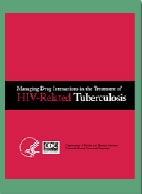 Managing Drug Interactions in the Treatment of HIV-Related Tuberculosis. In December 2007, CDC published these updated guidelines which include recommendations for use of newer antiretroviral drugs, including those in new classes, such as CCR5 receptor antagonists and integrase inhibitors. The new guidelines provide additional recommendations regarding use of rifampin with antiretroviral therapy; these recommendations are critical in regions where rifabutin is unavailable. Changes from previous versions of these guidelines include (1) summaries of clinical experience with use of specific antiretroviral regimens during tuberculosis treatment (in addition to pharmacokinetic data), (2) a table summarizing clinical experience with key antiretroviral regimens and providing recommended regimens, and (3) sections on treatment for special populations (i.e., young children, pregnant women, and patients with drug-resistant tuberculosis). The online guidelines will be updated periodically to provide clinicians with the latest information. These guidelines can be accessed here.
Managing Drug Interactions in the Treatment of HIV-Related Tuberculosis. In December 2007, CDC published these updated guidelines which include recommendations for use of newer antiretroviral drugs, including those in new classes, such as CCR5 receptor antagonists and integrase inhibitors. The new guidelines provide additional recommendations regarding use of rifampin with antiretroviral therapy; these recommendations are critical in regions where rifabutin is unavailable. Changes from previous versions of these guidelines include (1) summaries of clinical experience with use of specific antiretroviral regimens during tuberculosis treatment (in addition to pharmacokinetic data), (2) a table summarizing clinical experience with key antiretroviral regimens and providing recommended regimens, and (3) sections on treatment for special populations (i.e., young children, pregnant women, and patients with drug-resistant tuberculosis). The online guidelines will be updated periodically to provide clinicians with the latest information. These guidelines can be accessed here.
Guidelines for the Use of Antiretroviral Agents in HIV- 1-Infected Adults and Adolescents. On January 29, 2008, the DHHS Panel on Antiretroviral Guidelines for Adult and Adolescents released an updated version of these guidelines. The full version of the Guidelines can be accessed here. The section on Mycobacterium Tuberculosis Disease or Latent Tuberculosis Infection with HIV Coinfection can be found on pages 52-54 and related tables on pages 87-96. This section has been updated with the following information:
- Discussions and recommendations on the timing of initiation of antiretroviral therapy in patients with active tuberculosis (TB), with emphasis on the risks and benefits of concomitant therapy related to overlapping toxicities, drug interactions, CD4 cell counts, and potential for immune reconstitution inflammatory syndrome.
- Recommendation for repeat testing to detect latent TB infection in persons who had CD4 count <200 cells/mm3 and have tested negative prior to antiretroviral therapy and have improved CD4 count to >200 cells/mm3 (BII).
Handbook of Anti-Tuberculosis Agents Recently published by the Global Alliance for TB Drug Development, this handbook is targeted principally to the TB drug research community, but may be of some interest to practicing clinicians as well. It brings together pharmacological information on 27
drugs, including all drugs approved to treat TB, drugs in clinical
development for TB, and some approved drugs being
investigated for potential use in TB, such as moxifloxacin.
Referenced data include physical characteristics, basic biology,
efficacy and safety in humans, and results on absorption,
distribution, metabolism, and excretion (ADME). This
document can be accessed here.
Unified Health Communication 101: Addressing Health
Literacy, Cultural Competency, and Limited English
Proficiency. This is a free on-line learning experience that will
help you:
- improve your patient communication skills
- increase your awareness and knowledge of the three main factors that affect your communication with patients: health literacy, cultural competency and low English proficiency
- implement patient-centered communication practices that demonstrate cultural competency and appropriately address patients with limited health literacy and low English proficiency
You may choose to take the course for credit (CEU/CE, CHES, CME, CNE) or not for credit. The course has five modules and is estimated to take a total of 5 hours to complete. You may complete the course at your own pace. This course can be accessed here.
CDC Health Disparities Report In November 2007, CDC released a report entitled “Health Disparities in HIV/AIDS, Viral Hepatitis, Sexually Transmitted Diseases and Tuberculosis in the US: Issues, Burden and Response.” The report indicates that “disparities in TB persist among racial and ethnic minority populations in the United States but as of 2005, the burden of the disease is shifting. For the third consecutive year, Hispanics (30%) exceeded non-Hispanic blacks or African Americans (27%) as the racial/ethnic group with the largest percentage of total cases. Hispanics and Asians together represent almost 80% of TB in foreign-born persons and accounted for 45% of the national case total. Blacks or African Americans represent 19% of the national case total and 44% of the US born total.” The entire report can be accessed here.
RTMCC Training and Education Products Webpage This webpage was developed to succinctly display and provide access to the educational materials developed by the 4 CDC-funded TB Regional Training and Medical Consultation Centers (RTMCCs). These resources include print, audiotape, videotape, CD-based tools, and MP3 files. The webpage has a search feature and products can be sorted by Product Name, Year Published, and RTMCC that produced the product, with a link to each product for downloading. The Products Webpage can be accessed at here.
back to top
On the Lighter Side - Tuberculosis Sanatoriums in the Northeastern Region
Begun in the late 1800s, the sanatorium movement helped reduce contagion and provided a salubrious environment in which to convalesce. The peak capacity of 120,000 beds was reached in 1954 for an estimated 180,000 known active TB cases. Here are a few examples in the northeastern region.
| Gaylord Farms Sanatorium (1904) Wallingford, CT |
• 24 beds
• $7/week • Exclusively for persons in the early stages of pulmonary TB who are of very moderate means and residents of the state |

Under management of the New Haven County Anti-Tuberculosis League. Situated on a plateau overlooking the town. There is an administration building containing offices, rooms for the doctor and matron, recreation hall, and accommodations for 14 patients. Four cottages provide for 4 patients each, in rooms opening on porches. The kitchen, dining room, and laundry are in separate buildings. There is electric lighting and steam heat throughout and the water supply is from artesian wells. In connection with the Sanatorium is a 250 acre farm.
|
| The Maine Sanatorium (1904) Greenwood Mountain, ME |
• 30 beds (100 planned)
• $10/week; 6 free beds
• Exclusively for incipient cases of pulmonary TB |
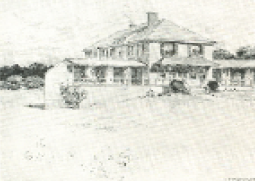
The State Association for the Treatment of Tuberculosis has secured 330 acres on a southern slope in the foothills of the White Mountains, at an altitude of 1,200 feet, near the Poland Spring region. Over a third of the estate is fertile arable land, which will make it possible to produce the required supplies of milk, fruit, and vegetables. Over 135 acres are woodland. The buildings are on the cottage system with individual sleeping rooms. Log camps, open on one side, are to be constructed for winter sitting-rooms. The sleeping pavilions have across the entire front double glass doors which are closed only while patients are rising and retiring Patients do not, however, dress in these pavilions, but go directly from them into heated dressing-rooms.
|
| Hospital for Consumptives of Maryland (1896) Towson, MD |
• 35 beds
• $3-10/week
• For patients preferably in the early stages of disease; under pressing circumstances far advanced cases are received |
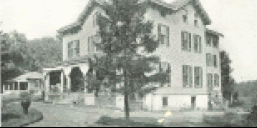
The hospital is located 8 miles from Baltimore and reachable in 30 minutes by electric cars. Also known as Eudowood Sanatorium, it is at an altitude of 500 feet among forest-covered hills. There is a large main building, containing 5 private rooms and two wards, one for men and one for women, one memorial cottage of 4 rooms and another of 6 rooms, all with porches looking south and west; 2 or 3 shacks and 2 or 3 army tents.
|
| Massachusetts State
Sanatorium
(1898)
Rutland, MA |
• 250 beds
• $4/week
• For early cases of pulmonary TB; must be residents of the state and not too far advanced |

The first state sanatorium in the country, it is located near the center of the state 11 miles from Worcester, at an elevation of 1000 feet. The buildings are on a southern slope, protected on the northwest by a wooded hill. The pavilions for patients are one or two stories high, extending to the south, each terminating in a solarium and piazza, and all connected on the north by a covered corridor.
|
| State Hospital for the Treatment of Incipient Pulmonary TB (1904) Ray Brook, NY |
• 120 beds
• Primarily for the poor; Others $5/week
• One year’s residence in state is required
• Incipient cases only |

The hospital is located in the Adirondacks, 6 miles west of Lake Placid. There is an administration building, with a pavilion on each side, connected with the central building by wings to be used as sun rooms. The altitude is 1625 feet and the 516 acres adjoins the Forest Preserve.
|
| Cleveland TB Sanatorium (1903) Cleveland, OH |
• 75 beds
• No charge
• For poor consumptives in any stage of the disease |

The Sanatorium is one building two stories high and 200 feet in length, situated 600 feet from any other building, on the brow of a hill overlooking the city. There are 4 wards and 16 private rooms, and 12-foot porches on 3 sides of the building.
|
| Hospital for Diseases of the Lungs (Wilstach Cottage) (1876) Chestnut Hill, PA |
• 60 beds
• No charge – Contribute according to means
• For poor women at all stages of pulmonary TB |
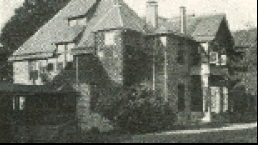
Established by the Philadelphia Protestant Episcopal City Mission, it was the first institution in Pennsylvania especially for consumptives. No distinction is made on account of nationality, creed, or color. Located 500 feet above tidal water, there are 4 hospital buildings and one administration building. Each patient has her own room. All bedrooms face south. Two buildings are furnished with wide open porches, on which patients’ beds are placed. In stormy weather heavy awnings are dropped to the floor. The fresh air treatment has been in force for 10 years.
|
Acknowledgement: The Committee on the Prevention of TB and the National Association for the Study and Prevention of TB: A Directory of Institutions and Societies Dealing with TB in the United States and Canada. Compiled by Lilian Brandt (1904)
back to top
Links - Other TB Resources
Division of Tuberculosis Elimination
The mission of the Division of Tuberculosis Elimination (DTBE) is to promote health and quality of life by preventing, controlling, and eventually eliminating tuberculosis from the United States, and by collaborating with other countries and international partners in controlling tuberculosis worldwide.
TB Education and Training Resources Website
This website is a service of the Centers for Disease Control and Prevention (CDC), Division of Tuberculosis Elimination. It is intended for use by TB and other healthcare professionals, patients, and the general public and can be used to locate or share TB education and training materials and to find out about other TB resources.
TB Education & Training Network (TB ETN)
The TB Education and Training Network (TB ETN) was formed to bring TB professionals together to network, share resources, and build education and training skills.
TB-Related News and Journal Items Weekly Update
Provided by the CDC as a public service, subscribers receive:
- A weekly update of TB-related news items
- Citations and abstracts to new scientific TB journal articles
- TB conference announcements
- TB job announcements
- To subscribe to this service, click here
TB Behavioral and Social Science Listserv
Sponsored by the DTBE of the CDC and the CDC National Prevention Information Network (NPIN), this Listserv provides subscribers the opportunity to exchange information and engage in ongoing discussions about behavioral and social science issues as they relate to tuberculosis prevention and control.
New England Tuberculosis Prevention and Control Website
At the beginning of 2005, the six New England TB Programs joined together to promote a regional approach to TB elimination. This web site represents a step toward building collaboration, exchanging experiences and practices, and enhancing program capacity.
Other RTMCCs
The Curry International Tuberculosis Center serves: Alaska, California, Colorado, Hawaii, Idaho, Montana, Nevada, Oregon, Utah, Washington, Wyoming, Federated State of Micronesia, Northern Mariana Islands, Republic of Marshall Islands, American Samoa, Guam, and the Republic of Palau.
The Heartland National Tuberculosis Center serves: Arizona, Illinois, Iowa, Kansas, Minnesota, Missouri, New Mexico, Nebraska, North Dakota, Oklahoma, South Dakota, Texas, and Wisconsin.
The Southeastern National Tuberculosis Center serves: Alabama, Arkansas, Florida, Georgia, Kentucky, Louisiana, Mississippi, North Carolina, South Carolina, Tennessee, Virginia, Puerto Rico, and the U.S. Virgin Islands.
back to top
Key Contacts
- Lee B. Reichman, MD, MPH - Executive Director
- Reynard J. McDonald, MD - Medical Director
- Bonita T. Mangura, MD - Director of Research
- Eileen C. Napolitano - Deputy Director
- Nisha Ahamed, MPH, CHES - Program Director, Education and Training
- Chris Hayden - Northeastern Spotlight Editor
- Alfred S. Paspe - User Support Specialist/Webmaster











